#Buttermilk diet
Text
#buttermilk#Buttermilk diet#diet tips#dieting#@na diet#healthy lifestyle tips#fitness tips#health tips#weightloss#healthy weight loss#lose weight#fat loss#fat belly#fat girl
0 notes
Text

The difference between buttermilk and sweet milk- In Appalachia, the term “sweet milk” refers to whole milk. Buttermilk is what’s left over from churning butter; it’s the liquid left in the churn after the butter has floated to the top.
Over centuries, buttermilk became a staple of the Appalachian diet, either as a cooking ingredient or a beverage. Its slightly tart taste appealed to many and it was especially popular in the days before refrigeration because its greater acidity made it slower to spoil than sweet milk.
Buttermilk was very popular in baking, especially biscuits and pastries. It was also served with meals as a drink. Cornbread was often crumbled into a glass of buttermilk, and when times were hard that might be all there was to be had for supper.
From The Laurel of Asheville via https://thelaurelofasheville.com/lifestyle/heritage/digital-heritage-buttermilk/
#appalachian#appalachian mountains#north carolina#appalachian culture#western north carolina#appalachia#the south#nc mountains
107 notes
·
View notes
Text



Simón had spent most of his time in Oasis Springs agonizing over Frida, after all, he was only here for her and although his mental had improved now that he was more away from the world of his past there was still the issue of her and what an issue it was.
He wanted to go to her, profess his love of her, make her understand that in the end, he couldn't be without her and show her that despite it all she, more than anyone else, had made him vulnerable.
But part of him knew it would be best to let her go. To stay away from her. After all, his life was misery and ill fortune, tying himself to her was sure to bring her down and after seeing how well she was doing for herself perhaps the only step forward was one without her.
So, Tuesday morning he talked with her father and asked what he should do. It was no surprise that the old man wanted him nowhere near his daughter. "You know how this ends for you, Simón, it ends tragically," her dad said. "And both of us have bought enough of that into her life."
Simón begrudgingly agreed but where did that leave him?

I think I've pretty much settled into Pascal's place I mean here I am once again making him breakfast but it really isn't official official, you know? I believe both of us wonder if this is all going too fast but who decides that really? Maybe, it's going at just the right pace?
Either way, I'm here cooking Oatmeal buttermilk pancakes, hoping this fits into his very strict diet.
I don't get too far into the preparation before he joins in and offers encouragement.
"You must be the perfect woman," he tells me and I can't help but to wink and smile his way. There's always a risk with him that it can turn into more. Eh, not a risk, a hope...but he does say he has a game today and so he needs to be very very focused for that.

That leaves me with plenty to do and before I could make a plan on what to do with my free time it is Irene who calls me and asks to come over. I met her at the food stand a day or so ago if you recall and I'm more than happy to get to know her better. I feel like out of all the people I've met I have the most in common with her and so I hope this is the start to a beautiful friendship.


Before she comes over I have time to make some ice cream and also mix some lemonade. Summer is coming up hard and fast here in Oasis Springs and you'd have to be stupid to find yourself outside without a cool drink or a handful of ice cream or something!

She strolls right up to the house after she hears me outside humming and making lemonade. I invite her to sit, thankful for the shade, and she's eager to jump right into a conversation about our shared hobby. Being chefs!
"I work at the Selva place, you know the one?"
I nod my head, once again thinking of Simón and the date we shared there and ummm, what happened after. Best not to think about that. "The food was really good! I plan on going back some day-"

"The boss is an ass but a loveable one," she says, joking. "Won't even hire anyone unless they have 'heritage' or whatever, which is silly but-"
"Oh? Is he hiring?" I say, pushing right past the red flag she had put before me and focusing on the opportunity. "Maybe he might be easier to deal with if you have a friend there to help you out?"

"Well, yes? Maybe? I think he might be. I could ask him for you but...like I mentioned, he's a bit of an ass! Be careful with him!"
I tell her I will and to go ahead and give him a good word for me. Who knows if I'll take the offer, who knows if I'll be offered, but I always consider an opportunity.
After that she talks a bit about my stand and how she is just a little jealous of it. "It's pretty bold," she says. "You're all on your own so if anything goes wrong, you are to blame. Takes a lot of courage."

"I guess...I felt like I had nothing to lose," I say, thinking about how she was right but when I started my stand I never thought of failure because I've lived through failure and tragedy and I've come out stronger. "You know it is fun, thinking about the recipes and all that and-"
"That's my dream you know? Having my own place..."
That is definitely a noble and respectable dream, one I think I share...

Irene has to go which of course leaves me home alone or...well, that's not technically my home but you know what I mean!
I could have sat there and watched television or something but instead decided to head to the gym. If Pascal is out playing a game with the team or whatever he's doing then I need to stay fit myself and what better way than yoga?
It was the perfect time for it too since there was no one else around.

And being at the gym meant it is likely that I run into Sara who I think was coming from her own light work out herself. She was super excited to see me and asked why I wasn't at home earlier. "Came to ask if you wanted to work out but you just arrived? What have you been up to?"
"I've been at Pascal's place," I come right out with it, watching her eyes grow big with excitement and demand.
"Oh! Wow! You HAVE to tell me about it!"

She drags me to one of the seats, sits across from me, and gives me a signal to go on. Looks like I have little option here but to indulge her need to know just a little bit although there isn't much for me to tell her. So, I just focus on the general feeling I have when it comes to him.
"He's simple, in a good way I mean. Keeps to himself, works out a lot, very focused on his career."
"See, see!" She says, referencing my conversation with her and Marjorie days ago. "Is it true? Is he trying to get transferred to Real Del Sol!?"

"Huh?" I have no idea what she's talking about.
"O-oh, just a rumor, Oasis FC you know, small team, respectable, but he's bound to outgrow them at this rate," she says nonchalantly. "Off to a bigger club to hopefully win championships and stuff. I just wondered if you'd have like the inside scoop-"

"Nooo," I'm shaking my head, regretting that I really know nothing at all about his career but I do know what that might mean for me, for us. "We don't talk much about fútbol honestly, it's not something he's mentioned."
"Hmm, I hope he doesn't go. As an OFC fan it'd suck to lose him."
"Yeah..." well, as his girlfriend it would suck too. I hope he doesn't go either but maybe it's just a rumor with nothing behind it? I'm just now getting to know him and if he were to go to another city would he ask me to come with?

Either way, right now I'll think nothing of it and enjoy the rest of my time at the gym.
Tomorrow is Summer Solstice and hopefully that means a pretty fun and eventful day. Let's hope at least!
Episode List - Next
#The Sims#The Sims 4#ts4#Sims#Sims 4#sims legacy#my sims#generation 1#soot#sims of our time#frida varela#simon barrera#pascal alcocer#irene tasis#sara chavez
25 notes
·
View notes
Text

"'Foolish’ dieting injured my health. I ate condiments until the lining of my stomach was raw. Warned by physicians that I must cease that practice, I decided to ‘eat nothing,’ and often lived for days on buttermilk. I tore down my physical resistance, and considerable medical care was necessary to gain my recovery. I still diet, but sensibly. I eat, but I do not partake of fattening foods.”
-Joan Crawford, Movie Classic, April 1933
21 notes
·
View notes
Text
You were once an athlete. Not the best one in your school, but your physique definitely portrayed you as one. Lean muscle, strong legs, and endurance to match. You ate a lot to keep up with that physical activity.
Then you went to college. Classes took priority and your diet never changed. Not by much. Some of the healthier meals were replaced with hot pockets and ramen. You tried to work out, but your physical activity diminished when your friend group grew. You spent so much time socializing and enjoying the company of friends that it was only a matter of time until that waistline stopped being so trim. Pants a little tighter, shirts lifting up a bit more, underwear cutting in a little to uncomfortably. It was only when you hit your second year that you realized you had been gaining weight.
Once it started to warm up for spring and you started putting on your tank top you noticed how difficult it was to bring below your navel. That soft mound of flesh that is starting to hide your feet is in the way. A prod here, a grab there, and you realize you have really put on some weight. Yes the panic sets in and you started to think on ways to lose it, but you had an appearance to maintain with your friends. So you bailed on spring break to try and workout. That's when you met me.
Of course I was also trying to lose weight and build an athletic figure, but you showed up and blew me away. I was a little chubby with a small potbelly and thicker thighs, but you definitely had me outclassed by 30+ pounds. Your belly hung over your belt buckle. Your developing second chin was almost prominent. You breathed so heavily that I felt mine leave me because you took my breath away. And I had to have you.
So I introduced myself. We talked and parted ways to other corners of the gym. Eventually, over a few weeks, we got closer and talked more. You lost some weight and so did I. We were both honestly very motivational to each other. You could fit in some of your early college outfits and I could fit into some of my old uniforms.
But I missed how big you were. We started dating and you were so easily molded. We built up such a rapport and you trusted me so much that you didn't realize I was upping your portions. Now, with you going to the gym you did pack on more muscle, but there was equal parts fat to go with it. Your abs forever being hidden by a layer of chub. Your biceps large, but ultimately soft. And that round face stayed round. It was only when one night you brought up that you couldn't seem to lose weight that I decided to lay down the bombshell statement;
"I love you at any size, and I wouldn't mind more of you to love~"
And that's when I had you. You were cautious at first. We talked about it and explained further how I love how fat you were and how you are now, but I did admit I would prefer if you were more fat than fit. And we came to an agreement. If you didn't enjoy being fat in a year's time then I have to help you lose weight. So, I helped you enjoy it!
I baked and cooked all of your meals. Made shakes with whey protein, bananas, and peanut butter to quicken your gains with some added buttermilk to speeden things up. And the amount of fat, sweaty sex that showed my appreciation for the art form that is your body. You grew so fast over the course of half a year. 95+ pounds later and you couldn't see your feet! Your belly rested halfway on your too thick thighs, and not to mention how difficult it was to get you in a chair. You started to long for my cooking and even begged at times for me to feed you. Unfortunately for my own figure I got overzealous and didn't realize you could only handle so much food and drink. So I had to have some of my own. And it made a lot of my outfits too tight. Button up shirts had to always be unbuttoned and I had to resort to stretchy waistbands for all of my pants.
And then the year mark came. You could barely move you were so obese. You forgot about the deal, but I didn't. I reminded you and now here you are. Wondering if you enjoy the state you are in. A nearly immobile monolith of fat.
So how does it feel~? Being a former athlete and now a product of a nurturing partner~
#muscle chub#soft belly#fit to fat#feedism kink#fat admirer#soft feedism#diet sabotage#mutual gaining#weight gain kink#wg text
47 notes
·
View notes
Note
Cheese is a dairy product produced in wide ranges of flavors, textures, and forms by coagulation of the milk protein casein. It comprises proteins and fat from milk (usually the milk of cows, buffalo, goats, or sheep). During production, milk is usually acidified and either the enzymes of rennet or bacterial enzymes with similar activity are added to cause the casein to coagulate. The solid curds are then separated from the liquid whey and pressed into finished cheese. Some cheeses have aromatic molds on the rind, the outer layer, or throughout.
A platter with cheese and garnishes
Cheeses in art: Still Life with Cheeses, Almonds and Pretzels, Clara Peeters, c. 1615
Over a thousand types of cheese exist and are produced in various countries. Their styles, textures and flavors depend on the origin of the milk (including the animal's diet), whether they have been pasteurized, the butterfat content, the bacteria and mold, the processing, and how long they have been aged. Herbs, spices, or wood smoke may be used as flavoring agents. The yellow to red color of many cheeses is produced by adding annatto. Other ingredients may be added to some cheeses, such as black pepper, garlic, chives, or cranberries. A cheesemonger, or specialist seller of cheeses, may have expertise with selecting, purchasing, receiving, storing and ripening cheeses.
For a few cheeses, the milk is curdled by adding acids such as vinegar or lemon juice. Most cheeses are acidified to a lesser degree by bacteria, which turn milk sugars into lactic acid, then the addition of rennet completes the curdling. Vegetarian alternatives to rennet are available; most are produced by fermentation of the fungus Mucor miehei, but others have been extracted from various species of the Cynara thistle family. Cheesemakers near a dairy region may benefit from fresher, lower-priced milk, and lower shipping costs.
Cheese is valued for its portability, long shelf life, and high content of fat, protein, calcium, and phosphorus. Cheese is more compact and has a longer shelf life than milk, although how long a cheese will keep depends on the type of cheese. Hard cheeses, such as Parmesan, last longer than soft cheeses, such as Brie or goat's milk cheese. The long storage life of some cheeses, especially when encased in a protective rind, allows selling when markets are favorable. Vacuum packaging of block-shaped cheeses and gas-flushing of plastic bags with mixtures of carbon dioxide and nitrogen are used for storage and mass distribution of cheeses in the 21st century.
Etymology
Various hard cheeses
The word cheese comes from Latin caseus,from which the modern word casein is also derived. The earliest source is from the proto-Indo-European root *kwat-, which means "to ferment, become sour". That gave rise to cīese or cēse (in Old English) and chese (in Middle English). Similar words are shared by other West Germanic languages—West Frisian tsiis, Dutch kaas, German Käse, Old High German chāsi—all from the reconstructed West-Germanic form *kāsī, which in turn is an early borrowing from Latin.
The Online Etymological Dictionary states that "cheese" comes from:
Old English cyse (West Saxon), cese (Anglian) ... from West Germanic *kasjus (source also of Old Saxon kasi, Old High German chasi, German Käse, Middle Dutch case, Dutch kaas), from Latin caseus [for] "cheese" (source of Italian cacio, Spanish queso, Irish caise, Welsh caws).
The Online Etymological Dictionary states that the word is of:
unknown origin; perhaps from a PIE root *kwat- "to ferment, become sour" (source also of Prakrit chasi "buttermilk;" Old Church Slavonic kvasu "leaven; fermented drink," kyselu "sour," -kyseti "to turn sour;" Czech kysati "to turn sour, rot;" Sanskrit kvathati "boils, seethes;" Gothic hwaþjan "foam"). Also compare fromage. Old Norse ostr, Danish ost, Swedish ost are related to Latin ius "broth, sauce, juice."
When the Romans began to make hard cheeses for their legionaries' supplies, a new word started to be used: formaticum, from caseus formatus, or "molded cheese" (as in "formed", not "moldy"). It is from this word that the French fromage, standard Italian formaggio, Catalan formatge, Breton fourmaj, and Occitan fromatge (or formatge) are derived. Of the Romance languages, Spanish, Portuguese, Romanian, Tuscan and Southern Italian dialects use words derived from caseus (queso, queijo, caș and caso for example). The word cheese itself is occasionally employed in a sense that means "molded" or "formed". Head cheese uses the word in this sense. The term "cheese" is also used as a noun, verb and adjective in a number of figurative expressions (e.g., "the big cheese", "to be cheesed off" and "cheesy lyrics").
A piece of soft curd cheese, oven-baked to increase shelf life
Cheese is an ancient food whose origins predate recorded history. There is no conclusive evidence indicating where cheesemaking originated, whether in Europe, Central Asia or the Middle East. Earliest proposed dates for the origin of cheesemaking range from around 8000 BCE, when sheep were first domesticated. Since animal skins and inflated internal organs have, since ancient times, provided storage vessels for a range of foodstuffs, it is probable that the process of cheese making was discovered accidentally by storing milk in a container made from the stomach of an animal, resulting in the milk being turned to curd and whey by the rennet from the stomach.
The earliest evidence of cheesemaking in the archaeological record dates back to 5500 BCE and is found in what is now Kuyavia, Poland, where strainers coated with milk-fat molecules have been found.
Cheesemaking may have begun independently of this by the pressing and salting of curdled milk to preserve it. Observation that the effect of making cheese in an animal stomach gave more solid and better-textured curds may have led to the deliberate addition of rennet. Early archeological evidence of Egyptian cheese has been found in Egyptian tomb murals, dating to about 2000 BCE. A 2018 scientific paper stated that the world's oldest cheese, dating to approximately 1200 BCE (3200 years before present), was found in ancient Egyptian tombs.
The earliest cheeses were likely quite sour and salty, similar in texture to rustic cottage cheese or feta, a crumbly, flavorful Greek cheese. Cheese produced in Europe, where climates are cooler than the Middle East, required less salt for preservation. With less salt and acidity, the cheese became a suitable environment for useful microbes and molds, giving aged cheeses their respective flavors. The earliest ever discovered preserved cheese was found in the Taklamakan Desert in Xinjiang, China, dating back as early as 1615 BCE (3600 years before present).
Ancient Greece and Rome
Cheese in a market in Italy
Ancient Greek mythology credited Aristaeus with the discovery of cheese. Homer's Odyssey (8th century BCE) describes the Cyclops making and storing sheep's and goats' milk cheese (translation by Samuel Butler):
We soon reached his cave, but he was out shepherding, so we went inside and took stock of all that we could see. His cheese-racks were loaded with cheeses, and he had more lambs and kids than his pens could hold...
When he had so done he sat down and milked his ewes and goats, all in due course, and then let each of them have her own young. He curdled half the milk and set it aside in wicker strainers.
Columella's De Re Rustica (c. 65 CE) details a cheesemaking process involving rennet coagulation, pressing of the curd, salting, and aging. According to Pliny the Elder, it had become a sophisticated enterprise by the time the Roman Empire came into being.
Cheese, Tacuinum sanitatis Casanatensis (14th century)
As Romanized populations encountered unfamiliar newly settled neighbors, bringing their own cheese-making traditions, their own flocks and their own unrelated words for cheese, cheeses in Europe diversified further, with various locales developing their own distinctive traditions and products. As long-distance trade collapsed, only travelers would encounter unfamiliar cheeses: Charlemagne's first encounter with a white cheese that had an edible rind forms one of the constructed anecdotes of Notker's Life of the Emperor.
The British Cheese Board claims that Britain has approximately 700 distinct local cheeses; France and Italy have perhaps 400 each (a French proverb holds there is a different French cheese for every day of the year, and Charles de Gaulle once asked "how can you govern a country in which there are 246 kinds of cheese?"). Still, the advancement of the cheese art in Europe was slow during the centuries after Rome's fall. Many cheeses popular today were first recorded in the late Middle Ages or after—cheeses like Cheddar around 1500, Parmesan in 1597, Gouda in 1697, and Camembert in 1791.
In 1546, The Proverbs of John Heywood claimed "the moon is made of a green cheese" (Greene may refer here not to the color, as many now think, but to being new or unaged). Variations on this sentiment were long repeated and NASA exploited this myth for an April Fools' Day spoof announcement in 2006.
Cheese display in grocery store, Cambridge, Massachusetts, United States
Until its modern spread along with European culture, cheese was nearly unheard of in east Asian cultures and in the pre-Columbian Americas and had only limited use in sub-Mediterranean Africa, mainly being widespread and popular only in Europe, the Middle East, the Indian subcontinent, and areas influenced by those cultures. But with the spread, first of European imperialism, and later of Euro-American culture and food, cheese has gradually become known and increasingly popular worldwide.
The first factory for the industrial production of cheese opened in Switzerland in 1815, but large-scale production first found real success in the United States. Credit usually goes to Jesse Williams, a dairy farmer from Rome, New York, who in 1851 started making cheese in an assembly-line fashion using the milk from neighboring farms; this made cheddar cheese one of the first US industrial foods.Within decades, hundreds of such commercial dairy associations existed.
The 1860s saw the beginnings of mass-produced rennet, and by the turn of the century scientists were producing pure microbial cultures. Before then, bacteria in cheesemaking had come from the environment or from recycling an earlier batch's whey; the pure cultures meant a more standardized cheese could be produced.
Factory-made cheese overtook traditional cheesemaking in the World War II era, and factories have been the source of most cheese in America and Europe ever since.By 2012, cheese was one of the most shoplifted items from supermarkets worldwide.
I’M NOT GRADING YOUR INFORMATIVE ESSAY.
9 notes
·
View notes
Text
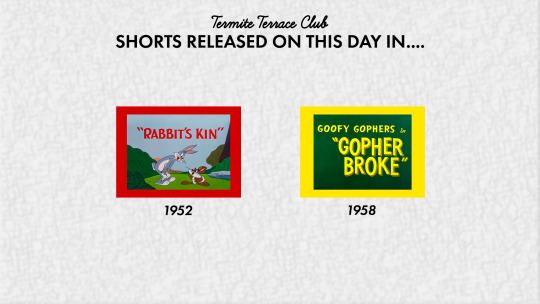
Termite Terrace Club - November 15th
1952 - Rabbit's Kin - Dir. Robert McKimson (The debut of Pete Puma)
1958 - Gopher Broke - Dir. Robert McKimson
#LooneyTunes #LooneyTwt #bugsbunny #petepuma #goofygophers #barnyarddawg
1978 - How Bugs Bunny Won the West
1979 - Bugs Bunny's Thanksgiving Diet
1996 - Space Jam (the debut of Lola Bunny)
TV
1990 - Tiny Toon Adventures Season 1: "Inside Plucky Duck" ("Bat's All Folks" / "Wild Takes Class")
1993 - Animaniacs Season 1 - "Buttermilk, It Makes a Body Bitter" / "Broadcast Nuisance" / "Raging Bird"
1994 - Taz-Mania - "Mutton for Nothing" / "Dr. Wendal and Mr. Taz"
1997 - Pinky and the Brain Season 3: "The Tailor and the Mice" / "Bah, Wilderness"
1997 - The Sylvester and Tweety Mysteries Season 3: "Yelp" / "Jeepers Creepers".
2003 - Duck Dodgers Season 1 Finale: "Enemy Yours" / "Duck Departure"
2011 - The Looney Tunes Show Season 1: "Beauty School" (Featuring the Merrie Melodies segment, "Giant Robot Love" with Daffy and Porky.)
#looney tunes#looneytwt#wb#wb100#warner bros#bugs bunny#pete puma#space jam#goofy gophers#barnyard dawg
5 notes
·
View notes
Text

COCA-COLA SHEET CAKE
Yield: 24-30 SERVINGS
INGREDIENTS:
CAKE:
2 cups all-purpose flour
1 1/3 cups granulated sugar
1/3 cup unsweetened cocoa powder
1 teaspoon baking soda
1/2 teaspoon salt
1/2 teaspoon instant coffee granules (optional)
1/2 cup vegetable oil
1 cup cola (not diet)
1/3 cup buttermilk (regular or low-fat)
1 teaspoon vanilla extract
FROSTING:
1/2 cup unsalted butter, diced
1/4 cup unsweetened cocoa powder
1/3 cup cola
1/2 teaspoon instant coffee granules (optional)
1 teaspoon vanilla extract
Pinch of salt
2 cups powdered sugar
Chopped pecans or walnuts for topping
DIRECTIONS:
Preheat oven to 350°F. Spray a 10x15 sheet cake pan with cooking spray (I like the kind with flour).
Whisk flour, sugar, cocoa, baking soda, salt, and coffee granules in a large bowl. Set aside.
Whisk oil, cola, buttermilk, and vanilla in a measuring cup. Stir wet ingredients into dry and stir until just blended and smooth.
Pour batter into prepared pan. Bake for about 15-22 minutes until a toothpick comes out clean 2” from the edge of the pan. The cake will somewhat spring back when touched.
As soon as the cake comes out of the oven, make the frosting. Heat the butter, cocoa, cola, and coffee granules in a small saucepan until it boils and the butter is melted. Remove from heat and stir in vanilla, salt, and powdered sugar. Pour evenly and carefully over cake, spreading as needed. Sprinkle with chopped nuts.
Cool completely before serving. Store loosely covered on counter or in refrigerator for up to 3 days.
10 notes
·
View notes
Text
9 Healthy Summer Foods To Keep Your Body Cool By Akshay Mendiratta

Mumbai is currently experiencing extremely hot climate, with temperatures soaring to 33.0 degrees these days which is excessive warmth. The Indian Meteorological Department has issued a warning announcing that the scenario can also get worse within the following few days. If you feel the effects of the scorching heat and want to cool down, here are a variety of foods suggested by Akshay Mehndiratta that let you beat the summer and keep your body cool.
Cucumber
Cucumbers are made up of 95% water and are therefore incredibly hydrating and also detoxify the body. Staying hydrated helps improve stool consistency, avoid constipation, and promote regularity. In addition, cucumbers contain potassium, fiber, magnesium, manganese and vitamins A, C, K. It has antimicrobial properties, helps in detoxification, digestion, preventing cancer and other bone diseases. Cucumbers may have anti-inflammatory benefits. Akshay Mehndiratta says, Cucumber is a great option to stay fresh and nourished during the summer season.
Watermelon
Watermelon contains about 90% water, making it useful for staying hydrated in summers and providing your body with powerful antioxidants and essential vitamins. It can also satisfy the sweet tooth with its natural sugars. Watermelon is rich in vitamins A and C as well as potassium, magnesium and dietary fiber. Watermelon is a low-calorie food, making it a great choice for people who are watching their weight or trying to maintain a healthy diet. Overall, adding watermelon to your diet during summer can provide a variety of health benefits and can help keep you cool and hydrated during the hotter months.
Leafy Greens
Akshay Mehndiratta enjoys eating leafy vegetables because he understands how they benefit vision, skin health and the immune system. That’s why he suggests eating leafy vegetables like spinach, kale and lettuce, which have many health benefits, especially during summer. Green vegetables contain a variety of nutrients, including vitamins A, C, K and folate, as well as calcium and potassium. These nutrients can help boost your immune system, strengthen bones and teeth, and keep your body running smoothly. The fiber present in green vegetables can help support good digestion and regularity, which is especially beneficial during the summer when outdoor activities and travel can disturb habits.
Buttermilk
Buttermilk is a natural source of electrolytes, which helps restore fluids lost through sweat and keeps you hydrated during hot summer days. It increases liver function and when you consume buttermilk daily, toxins are easily eliminated from your body. Because it contains riboflavin, which helps in converting food into energy. A glass of buttermilk mixed with cumin, mint and salt is ideal to quench the thirst and cool our body during the hot summer months of April to July, says Akshay Mehndiratta.
Mango
Mangoes are tropical fruits that thrive in warm temperatures and the summer months are optimal for their growth and ripening. Mangoes are beneficial for keeping cool and hydrated in the heat. Mangoes are high in water content, making them an ideal fruit to consume throughout the hot, humid summer. Moreover, mangoes are low in calories and high in fiber. They include folate, beta keratin, iron, vitamins A and C, and levels of calcium, zinc and vitamin E. Overall, mangoes offer many health benefits.
Berries
Berries are a summer superfood rich in critical minerals and antioxidants. Their high water content keeps you hydrated in hot conditions and their bright colors indicate a wealth of vitamins and minerals. Berries are low in calories and high in fiber, making them great for weight loss and digestion. Plus, their inherent sweetness satisfies sugar cravings without the need for added sugar. Berries in your summer diet can help with general health, immunity and glowing skin.
Curd
Akshay Mehndiratta constantly recommends dairy products as they help regulate body temperature to a great extent. Curd is a popular summer dish because of its cooling effects and many health benefits. Eating curd in summer is healthy. Curd has a cooling effect on the body, making it a great food to drink on hot summer days. Curd is high in protein and contains vitamins B12 and D, both of which are essential for immune system function. Curd contains probiotics, which help improve the immune system by promoting antibody production and increasing the body’s ability to fight infections. Curd is a refreshing and healthy option that helps you stay cool.
Citrus food
Citrus fruits are essential in summer due to their pleasant taste and various health benefits. They are rich in vitamin C, which boosts immunity, and their high water content helps us stay hydrated in the heat. They are high in antioxidants, which protect your skin from UV damage, making them ideal for summer snacking, drinks and desserts. Plus, their soluble fiber promotes digestion, prevents constipation, and their low calorie and high fiber content helps with weight management by increasing satiety and reducing calorie intake, making them an excellent choice for summer snacks and meals.
Coconut
Coconut is a summer favorite, offering a variety of benefits for this season. Coconut water, which contains electrolytes like potassium and magnesium, helps restore fluids lost through sweat, making it a great natural way to stay hydrated in the heat. Coconut also contains lauric acid, which has antibacterial properties and can help strengthen the immune system when exposed to overgrown germs. Coconut meat is high in healthy fats, which provide long-lasting energy and increase satiety, making it an ideal snack for active summer days. Plus, both coconut water and coconut meat are high in antioxidants, which help combat oxidative stress and inflammation, promoting general health and well-being throughout the summer months.
As summer temperatures rise, it’s important to stay cool, hydrated and energized. According to Akshay Mehndiratta, adding nine nutritious summer foods to your diet will keep your body cool and your mind refreshed. Cucumbers, watermelons, and citrus fruits are many tasty and healthy foods. So, fight the heat this summer by loading your plate with these refreshing foods and reap the benefits of a cool, nutritious diet.
2 notes
·
View notes
Text



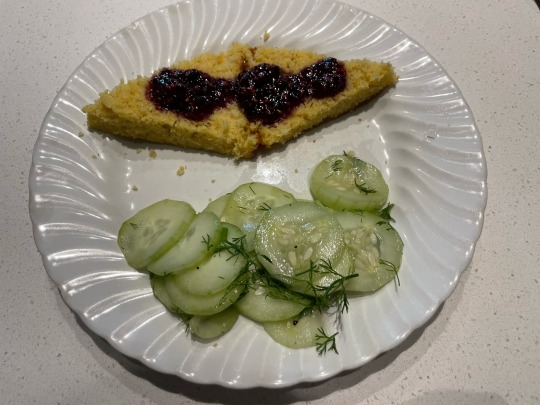

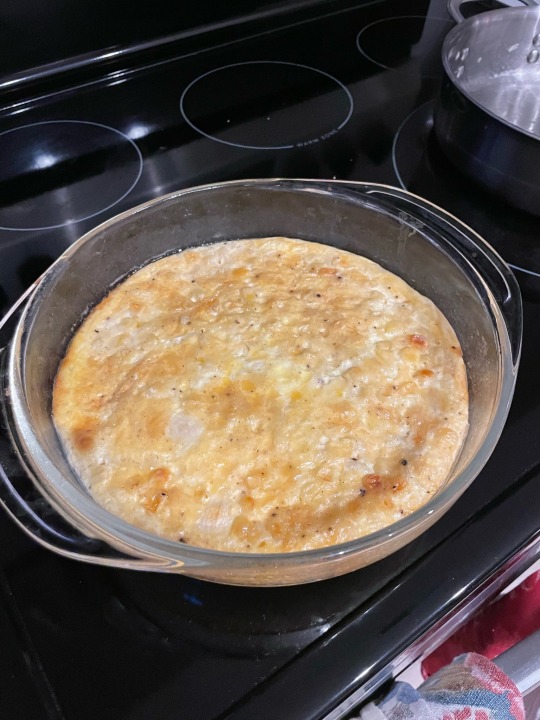
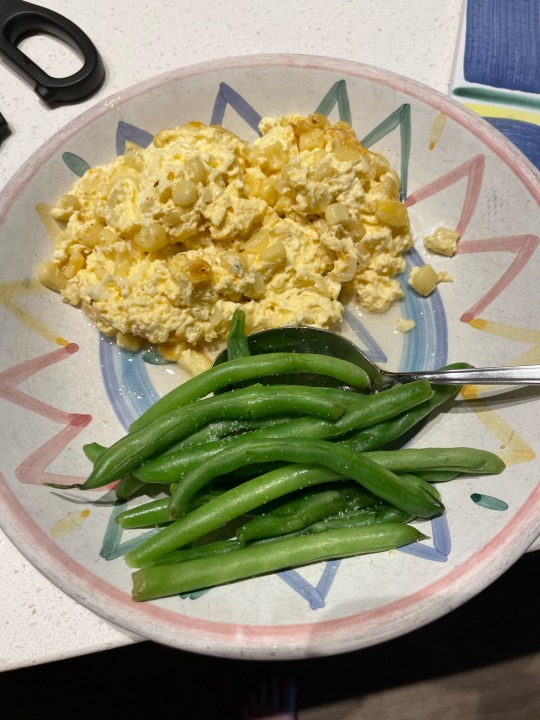
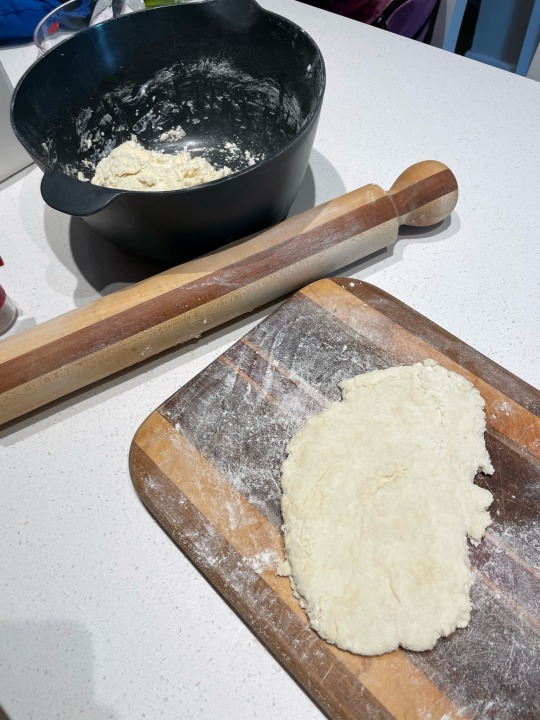
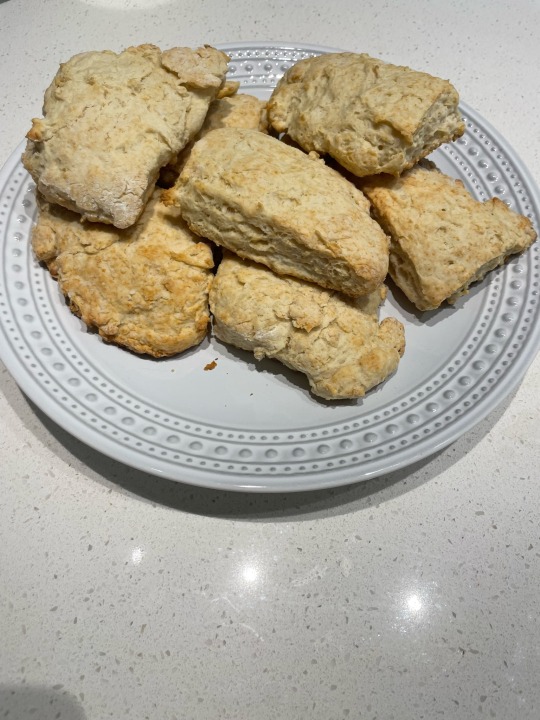
I have been experimenting with the Mormon pioneer cookbooks I brought back from Utah with generally really good results, and had a lot of fun!
cornbread + Danish cucumber salad + homemade blackberry jam (not from the cookbooks, just general home jam I thought would fit nicely with cornbread)
leek pie
corn pudding
buttermilk biscuits
the cornbread and biscuits are essentially variations on the theme of any other cornbread or biscuit recipe i've used, and I've made both from scratch pretty regularly. It was kind of nice to think about these bread products that were a cornerstone of 19th century diets sticking around, though!
the corn pudding recipe surprised me because it didn't contain any flour, so it was texturally different than other dishes called corn pudding I'm familiar with, but also different from the creamed corn recipe I use, which is similar in ingredients but cooked in a pan on the stove not in the oven. It was good, though!
the leek pie was good flavor-wise but I got really sick of eating it several meals later so I think it would be better if you served it all at once to more than one person. Also, the recipe called for the filling in the pie tin and a crust laid on top, and I used a bottom crust because I had a frozen crust, and it got a little soggy from all the water-heavy leeks, so I think following the recipe directly would probably be tastier if less pretty.
No notes on the cucumber salad, it's essentially just a quick pickle recipe but it is a super nice and refreshing side that goes well with anything.
I think I'm going to try some of the more heavily involved/special occasion dishes next!
14 notes
·
View notes
Text
What Causes High cholesterol ?
The word "high cholesterol" refers to a growth in blood cholesterol levels, which mainly increases the chance of acquiring serious conditions like heart disease and stroke later on. One kind of lipid that the body releases naturally by the liver is cholesterol, which is a waxy, fat-like material. Its synthesis is seriously needed for the synthesis of several hormones, vitamin D, and the outer layer of cells. The liver makes cholesterol, which is mostly composed of fat and protein, to transport cholesterol. They are in charge of transporting triglycerides, another kind of fat, and cholesterol through the circulation. Hyperlipidemia or hypercholesterolemia are other terms for high cholesterol.
The Main Causes of High Cholesterol

1. Unhealthy Diet: It includes high carbohydrates, sugar, red meat, high-fat, deep-fried and processed foods, bakery items, etc. Increase your cholesterol levels.
An unhealthy diet heavy in trans and saturated fats is one of the main causes of high levels of cholesterol. Among the foods that might increase cholesterol are:
The food is deep-fried.
Hot dogs, sausage, meat, and fatty portions of red meat.
Processed foods, such as white biscuits and bread.
Dairy foods high in fat, such as cheese, milk, and buttermilk.
Baked products, such as cupcakes, brownies, cookies, and cakes.
2. Overweight: The extra fat in your body can be responsible for heart disease in the future.
3. Lack of physical activity: Due to Lack of physical activity puts you at risk of gaining weight and having more fat in your body than muscle. Physical workout helps improve your good cholesterol.
4. Age: This is not as much in your control, however in some cases, irrespective of age or gender, you might have high cholesterol levels.
5. Hereditary: Well, if it runs in the family, don’t be surprised if you suffer from high blood cholesterol.
6. Alcohol: If you are indulging in too much alcohol then it increases your cholesterol level and increases the possibility of heart disease.
Consult a healthcare professional for personalized advice based on your specific health condition.
Wishing you a swift recovery.
https://bit.ly/3HmDhcA
3 notes
·
View notes
Note
🍋 : what kind of diet does my muse have? do they eat regularly, or the standard 2-3 meals a day? do they have to be reminded to eat, or are they likely to remind others? do they cook, or have others cook for them? do they eat healthily, or not so much? { crane }
Air. His diet is air. Oxygen. With the occasional spot of dissociative hallucinogenic anesthetic designed to stimulate the amygdala. Or: a simple prescription sedative. "Snorted, not stirred." (Kidding. He prefers general anesthesia for sleep. Propofol is a good one. Less chance of The Long Nap.)
When he's ingesting food, it's 75% of the time going to be something that comes in a small package. Bonus points if it's calorie dense. Protein bars; yogurt cups; fruit cups (fresh); oatmeal packets (sometimes he eats those dry, man has no time); seeds/nuts (almonds. Almonds™.); chocolate darker than his soul (and his coffee — he runs on coffee most of the time, and that stuff looks like ancient, unchanged motor oil); chips.
One might think him more inclined to make up for the malnourished years of his childhood; instead, he's gotten used to it, which he would consider a perk, given how he manages his time.
But C, can he cook?
Yes. (Bet you didn't see that coming on this blog. Maybe. I mean, you think Bruce knows what he's doing in a pantry, let alone a fully-stocked kitchen? You think the Clown Prince of Crime spends his Saturdays perfecting the culinary arts?)
Okay, so what can he cook?
Soul foods (think red beans and rice, gumbo, chicken chili, collard greens, macaroni & cheese, mashed potatoes, buttermilk biscuits in gravy + general breakfast meats, cornbread)
Pumpkin / squash soup
Pie ("pie" is very general, which essentially means: he enjoys the scientific precision required for a pie. So he'll try it.)
Most red meats
Most fish
Shrimp
Vegetables are easy
He can do basically anything with fruit.
He has cooked for people in the past. He doesn't particularly enjoy it. (*He doesn't particularly enjoy people. The cooking is fine.)
Now somebody please go remind the doctor he hasn't eaten in 48 hours.
#::𝒹𝓇. 𝒸𝓇𝒶𝓃𝑒#. conceptualizing#{ these diet questions (i've gotten quite a few) are making me realize none of my muses either a) know how to cook or b) choose to. }#. in my opinion {ask}
4 notes
·
View notes
Text
FOOD RULES:
*No Soda -except the occasional Diet Coke
*No sweets ——unless it’s my frozen fruit pops or something sugar free
* No Fried Food( If you break this you must go on 3 day fast)
*Limit Dairy intake so no cheese , whole milk or creams/pudding/buttermilk etc ———only exceptions are low fat/no fat cottage cheese and if dairy is an ingredient in one of your safe foods
It’s better to have safe versions of your “no foods ” then to completely give into temptation. However , Fried foods for me are a HARD no, they’re greasy , fatty and low effort and remind me too much of what I’m trying not to be. But the rest I have “hacks”.
Remember your key to success lies in starvation. If you are not hungry then you are failing yourself and your dream body. ✨
#ana shit#meanspø#tw ana shit#tw ana diary#disordered eating in tags#disordered eating mention#ana trigger#i want to be weightless#th1gh g@p#ed bllog
6 notes
·
View notes
Note
Ur autistic Goro headcannon is so dumb i bet u also think he doesnt eat pancakes
Kys
well i think he does eat them but only in a preformative sense. he says outright he doesn't really enjoy sweet things that one time, and all the promo art establishes he means sweet buttermilk pancakes and not crepes - which are more neutral imo. though i am a shameless contrarian so i am open to discussion about his diet. i think he's more a rice and fish person. what do you think? similarly, how likely is it you think that goro akechi has lactose intolerance? awating your response eagerly, k.y.s.
regards, c. ram
22 notes
·
View notes
Text
Wonder millet, Finger millet ( Nachni/Ragi)
Finger millet, commonly referred as Ragi/nachni, is a nutritious millet, which is a great inclusion for health maintenance. It is local, cheap and complete food considering Indian diets.
Ragi or Finger millet generically known as ‘Eleusine Coracana’ is a gluten free, high calcium, iron, high fiber millet and a good source of protein. It has important amino acid called ‘Methionine’, an active amino acid directing synthesis of other amino acids.
Ragi is gluten free is easy absorbed in intestine. Ragi adds to the richness in nutritive profile, as it is also high in B class of vitamins and folic acid (significant in synthesis of red blood cells). Ragi, known for its wow factor, can blend flawlessly in any recipe, as primary or secondary ingredient.
Talking about its nutritional composition, Ragi has a gifted nutritional profile and is considered as balanced ingredient for maintaining nutrition integrity, here is the nutritional composition of the millet.
Energy
328 Kcal
Proteins
7.3 g
Carbohydrates
72 g
Fats
1.3 g
Calcium
344 mg
Phosphorus
283 mg
Iron
3.9mg
(The values are based on 100 g of edible portion)
Extraordinary qualities of extraordinary millet
Gluten free: - Being gluten free, Ragi is a great for those with constant complain of abdominal discomfort, gluten intolerance, celiac disease etc. Ragi is extremely soothing on GI system. This millet is light on digestion and does not pose any demerits.
High Tryptophan: -Tryptophan is an essential amino acid (which cannot be synthesised in the body), a precursor to brain chemical ‘serotonin’, which helps in relaxation of the brain neurons, inducing good sleep. People with history of insomnia, sleeping disorder or stress disorders, should include ragi in their meals.
High in Calcium and Iron: - Being extremely high in calcium and iron, it helps in synthesis of red blood cells production and prevents osteoporosis (brittle bones and bone loss) in small babies and adults. It is recognised as immunity booster and plays a very important role in overall development.
Natural coolant: - Ragi in combination with buttermilk acts as a natural coolant and a probiotic, thriving growth of good bacterial strain in gut, keeping gut in best health. It increases gut efficiency many folds.
Hands-on ingredient: - Ragi can combined well with any recipes like porridges, smoothies, parathas, khichadi, ladoos etc. Ragi is locally available and is reasonably priced.
One shot meal: - Ragi recipes are usually quick enough to make and it is amongst the non-perishable ones. Ragi recipes are time saving and nutritious, from deserts to breakfast items, Ragi can be rotated accordingly.
A complete food: - Ragi can be used as a better replacement to wheat and rice for its complete nutritional profile as it is unprocessed. It can safely be consumed by anyone irrespective of the age, Ragi is well tolerated by all. It is easy to digest and loaded with almost all vital nutrients.
Weight management: - Ragi millet can be a great inclusion for any weight loss or weight gain management diet plan. Ragi is amongst few food items which can pose positive effect on nutrition and malnutrition. It manages to provide just right calories and nutrient supply ensuring sustainable results. It is also great to take care of ailments related to insulin resistance, liver and heart.
Superior antioxidant load: - Ragi millet is high on phenolic compounds, which have essential role to protect body against harmful oxidative stress, having anti-inflammatory effect on body.
Ragi flour can be used in preparing upma, idlis, dosas, ladoos etc. Ragi malt can be used to make porridges, dry fruit laddos, milkshakes etc. It is always better to dry roast the flour or malt before using to enhance richness of flour due to its high levels of polyphenolic compounds, which have high antioxidant properties. Ragi flour, Ragi malt can be used in making various delicacies, having excellent nutrition profiling, augmenting growth and development.
4 notes
·
View notes
Text
A Vegan Guide to Dairy Alternatives
Dairy is one of the hardest and the best things to give up on. Milk and other dairy items are the top wellsprings of saturated fat adding to heart disease, type 2 diabetes, and Alzheimer's infection. Studies have likewise connected dairy to an expanded risk of breast, ovarian, and prostate cancers. If you’re ready to ditch dairy, then I have carved the best alternatives for you that will not only savor your taste buds but also bring warmth to your heart.
Say Hi to your new ultimate comfort foods.
Soy Milk
Soy Milk is enriched with protein. It is one of the most popular non-dairy milk of choice and is available at most grocery stores, coffee shops, and even restaurants around the country. It is perfect for people who are lactose intolerant. It is thick, creamy, and has a subtle flavor that makes it the perfect replacement. It is power-packed with Omega-3 fatty acids, which are healthy fats that the body can’t develop on its own. On top of it, it reduces the risk of dementia and Alzheimer's disease.
Quick Tip: When mixed with vinegar, soy milk curdles into a delicious "buttermilk" alternative which is great for muffins, pancakes, and quick bread.
Cashew Milk
Next comes the cashew milk. Cashew milk has a fine, creamy texture, almost flavorless, making it more similar to cow’s milk. It is relatively harder to find in the stores but you can easily find it in large grocery stores or bakeries.
Quick Tip: It is great for the base of custards and ice creams as well as for drinking. You can also enjoy it with oatmeal or cereal.
Oat Milk
It is derived from oat grains making it one of the healthiest plant-based milk. It has a creamy texture and has an oatmeal-like flavor. You can taste a variety of them such as Sweetened, Unsweetened, Vanilla, or Chocolate. It is one of the leading allergy-friendly milk. It can easily be made at home with 4 ingredients in under five minutes. Thinking of wasting five minutes a day, try cooking.
Quick Tip: It blends well with cookies, oatmeal's. Hence, it is relatively less desirable to drink and cook.
Almond Milk
Almond milk is one of the best and most popular replacements. You can easily find it next to your home. If you are diet conscious, then almond milk is the best one to go. It has 50% lower calories than cow milk. Not only does it strengthen the bones, but it is also highly nutritious. It’s chock full of Vitamin E & D. You can easily make it at home with two ingredients. Only 2, Isn’t it crazy?
Quick Tip: Almond Milk is incredibly versatile. It can be used as a milk replacement in smoothies, ice-creams, and shakes. You can also use it in salad dressings, soups, sauces, and baked foods to make your meal delicious and super creamy.
Coconut Milk
Coconut Milk is the most versatile milk available in the market. It has two major varieties: Boxed & Canned. It is highly rich in antioxidants. It prevents anemia and strengthens the immune system. You can find it nearby in supermarkets. It has a strong flavor and tastes really good so it is best appropriate for the ones who love coconut.
Quick Tip: It is great for vegan ganache and homemade ice cream.
Other Milk Alternatives
Hazelnut Milk
It is creamy and profoundly used in chai lattes and chocolates. It is also a great alternative to hazelnut-based desserts.
Macadamia Milk
It is thick and creamy with a slightly nutty flavor. It works best in hot beverages such as matcha lattes.
Hemp Milk
It has tons of health benefits. It reveals a great flavor when used in smoothie bowls and creamy pasta.
Rice Milk
It can be used in various recipes and is the most common alternative for making chai tea. Rice is rich in Vitamin B, Magnesium, Phosphorus and is packed with carbohydrates, making it a higher source of energy.
Flax Milk
It is lightweight and relatively flavorless. It is enriched with alpha-linoleic acids, which are used to prevent and treat diseases of the heart and blood vessels.
Are you shocked after seeing these many alternatives? So was I, when I discovered it for the first time.
2 notes
·
View notes